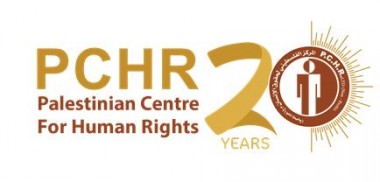The Palestinian Center for Human Rights (PCHR) published a new report as part of the series of the monthly “Closure Reports” addressing the latest developments of the state of the Gaza Strip border crossings in May 2016.
The report documents the impact of the ongoing Israel-imposed siege on Palestinian civilians, which affects their economic and social conditions.
It also refutes Israel’s claims that it has eased the closure of the Gaza Strip for the ninth consecutive year.
Furthermore, the report highlights that the continuing Israeli measures aim at the institutionalization of the closure and making the illegal restrictions imposed on the movement of persons and goods acceptable on the international level although they violate the international law, including the international humanitarian and human rights laws.
During the reporting period, Israeli forces allowed the entry of 14,464 truckloads, the majority of which were foodstuffs and consumables; an average of 466 truckloads daily.
Despite the number of truckloads allowed to enter the Gaza Strip has increased comparing with April, they are still limited quantities that do not meet the basic needs of the Gaza Strip.
Moreover, the Israeli forces continued to impose tightened restrictions on the exportation of the basic goods and commodities especially materials needed for the infrastructure projects and materials needed for manufacture and production.
Many obstacles were imposed on the entry of imports including the frequent closure of the only commercial crossing in the Gaza Strip, Karm Abu Salem (Kerem Shalom); the crossing was closed for 10 days (32.2% of the total period).
During the last week of May, the Israeli forces allowed the entry of construction materials into the Gaza Strip according to the UN’s Gaza Reconstruction Mechanism after preventing the entry of construction materials for the private sector for 40 days.
As a result, hundreds of private under-construction housing projects stopped in addition to other Reconstruction projects carried out by the Palestinian private sector. Stopping construction works in these projects will aggravate the suffering of civilians who are in desperate need for building their houses and facilities.
This will also inflict heavy losses on the private sector’s companies due to stoppage of work and increase the already high unemployment and poverty rates among the workers and their families. In a limited exception, the Israeli authorities allowed the entry of very limited quantities of construction materials for the intentional organizations and Qatari projects.
According to the National Ministry of Economy, the Israeli authorities allowed the entry of 37,520 tons of cement, 5,040 tons of construction steel and 227,600 tons of aggregate (2.5%, 1% and 7.5% of the total construction materials needed for the Gaza Reconstruction.)
Concerning the exports, Israeli forces continued to impose almost-complete ban on the Gaza Strip’s exports to the West Bank, Israel and abroad with the exception of limited quantities.
During the reporting period, 193 truckloads were allowed for exportation to the West Bank; 133 truckloads of which were agricultural products, 3 truckloads of fish, 4 truckloads of furniture, 3 truckloads of clothes, 3 truckloads of scrap and a truckload of stationary. The rate of the Gaza Strip exports for April constitutes 2.9% of the exports before June 2007.
As for the movement of persons, the Gaza Strip population has been denied their right to the freedom of movement and has been suffering due to obstacles imposed on their movement at all border crossings that connect the Strip with the West Bank and Israel.
Moreover, during the reporting period, Israeli forces imposed severe restrictions on the movement of Gaza population at Beit Hanoun (Erez) crossing, the only crossing for the movement of persons to the West Bank, including Jerusalem, and/or Israel.
As a result, 2 million people have been denied their right to the freedom of movement. A limited number of Palestinians were allowed to travel via the crossing: 1,553 patients, 1,403 patient companions.
During the reporting period, Israeli forces, 8,211 traders, 1,431 people with special needs, 761 workers of international humanitarian organizations and 207 persons travelling via al-Karama crossing.
It should be noted that these estimations do not emphasize the number of persons allowed to travel which is much less than times of travel. Those who have permits are allowed to travel more than one time a month.
They also allowed 1,307 person to visit holy places in the West Bank, 1,114 elderly people to cross Beit Hanoun (Erez) crossing and perform prayers in al-Aqsa Mosque and 193 Christian citizens in light of complicated security measures, including delaying their entry into the Gaza Strip for days before allowing them to enter.
Furthermore, Israeli forces arrested a patient while crossing the Beit Hanoun “Erez” crossing when he was on his way back along with his mother from “Barzilai” Hospital where he received medical treatment. It should be noted that the patient is still under arrest.
During the reporting period, Rafah International Crossing Point was closed during May for 31 days. This unveiled the reality of the situation in the Gaza Strip under the policy of collective punishment and the Israeli closure imposed over all border crossings, especially Beit Hanoun crossing.
The number of Palestinians, who registered for traveling via the crossing and are waiting for their turn to travel, was over 30,000, including 5,000 patients, in addition to thousands of Palestinians who want to travel but did not registered for traveling according to the Ministry of Interior in Gaza.
In the report’s recommendations, PCHR called upon the international community, particularly the High Contracting Parties to the Fourth Geneva Convention Relative to the Protection of Civilian Persons in Time of War, to immediately intervene to compel Israeli authorities to open the Gaza Strip crossings and put an end to the grave deterioration of humanitarian situation in the Gaza Strip.
The full report is available online at: State of crossings-May 2016

